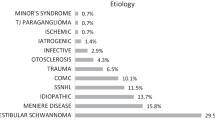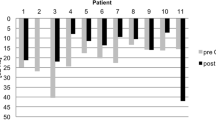Abstract
Background
The rehabilitation of patients with single-sided deafness (SSD) or asymmetric hearing loss can be achieved with conventional (Bi)CROS hearing aids ((Bi)CROS-HA, (Bi)CROS), bone conduction devices (BCI) or with cochlear implants (CI). Unfortunately, only small case series have been published on the treatment outcomes in SSD patients after CI surgery and there are only a few comparative studies evaluating rehabilitation outcomes.
Objective
The aim of this study was to provide evidence of successful treatment of SSD and asymmetric hearing loss with a CI compared to the untreated, monaural hearing condition and the therapy options of BCI and (Bi)CROS in a large number of patients.
Materials and methods
In a single-centre study, 45 patients with SSD and 40 patients with asymmetric hearing loss were treated with a CI after careful evaluation for CI candidacy. Monaural speech comprehension in noise and localisation ability were examined with (Bi)CROS-HA and BCI devices (on a test rod) both preoperatively and at 12 months after CI switch-on. At the same intervals, subjective evaluation of hearing ability was conducted using the Speech, Spatial and Qualities of Hearing Scale (SSQ).
Results and discussion
This report presents the first evidence of successful binaural rehabilitation with CI in a relatively large patient cohort and the advantages over (Bi)CROS and BCI in smaller subgroups, thus confirming the indication for CI treatment. Moreover, patients with long-term acquired deafness (>10 years) show a benefit from the CI comparable to that observed in patients with shorter-term deafness.




Similar content being viewed by others
Literatur
Aschendorff A, Laszig R, Beck R, Schild C, Kroeger S, Ihorst G, Wesarg T (2011) Comparison of pseudobinaural hearing rehabilitation to real binaural hearing after cochlear implantation in patients with unilateral deafness and tinnitus. Otol Neurotol 32:39–47
Arndt S, Laszig R, Aschendorff A, Beck R, Schild C, Hassepass F, Ihorst G, Kroeger S, Kirchem P, Wesarg T (2011) Einseitige Taubheit und Cochleaimplantat-Versorgung – Audiologische Diagnostik und Ergebnisse. HNO 59:437–446
Borton S, Mauze E, Lieu J (2010) Quality of life in children with unilateral hearing loss: a pilot study. Am J Audiol 19:61–72
Boyd PJ (2015) Potential benefits from cochlear implantation of children with unilateral hearing loss. Cochlear Implants Int 16:121–136
Buechner A, Brendel M, Lesinski-Schiedat A, Wenzel G, Frohne-Buechner C, Jaeger B, Lenarz T (2010) Cochlear implantation in unilateral deaf subjects associated with ipsilateral tinnitus. Otol Neurotol 31:1381–1385
Cohen J (1988) Statistical power analysis for the behavioral sciences, 2 edn. Lawrence Erlbaum, Hillsdale
Firszt JB, Holden LK, Reeder RM, Cowdrey L, King S (2012) Cochlear implantation in adults with asymmetric hearing loss. Ear Hear 33:521–533
Firszt JB, Holden LK, Reeder RM, Waltzman SB, Arndt S (2012) Auditory abilities after cochlear implantation in adults with unilateral deafness: a pilot study. Otol Neurotol 33:1339–1346
Flynn M, Sammeth C, Sadeghi A, Cire G, Halvarsson G (2010) Baha for single-sided sensorineural deafness: review and recent technological innovations. Semin Hear 31:326–349
Franko-Tobin E, Camilon PR, Camposeo E, Holcomb MA, Meyer TA (2015) Outcomes of cochlear implantation in adults with asymmetric hearing loss. Otol Neurotol 36(3):409–415
Gatehouse S, Noble W (2004) The Speech, Spatial and Qualities of Hearing Scale (SSQ). Int J Audiol 43(2):85–99
Grunder I, Seidl RO, Ernst A, Todt I (2008) Wertigkeit der BAHA-Testung für das postoperative Hörergebnis. HNO 56:1020–1024
Hansen MR, Gantz BJ, Dunn C (2013) Outcomes after cochlear implantation for patients with single-sided deafness, including those with recalcitrant Ménière’s disease. Otol Neurotol 34(9):1681–1687
Hol M, Kunst S, Snik A, Bosman A, Mylanus E, Cremers C (2010) Bone-anchored hearing aids in patients with acquired and congenital unilateral inner ear deafness (Baha CROS): clinical evaluation of 56 cases. Ann Otol Rhinol Laryngol 119:447–454
Jacob R, Stelzig Y, Nopp P, Schleich P (2011) Audiologische Ergebnisse mit Cochlear implant bei einseitiger Taubheit. HNO 59:453–460
Kenworthy OT, Klee T, Tharpe AM (1990) Speech recognition ability of children with unilateral sensorineural hearing loss as a function of amplification, speech stimuli and listening condition. Ear Hear 11:264–270
Linstrom CJ, Silverman CA, Yu GP (2009) Efficacy of the bone-anchored hearing aid for single-sided deafness. Laryngoscope 119:713–720
Nawaz S, McNeill C, Greenberg SL (2014) Improving sound localization after cochlear implantation and auditory training for the management of single-sided deafness. Otol Neurotol 35(2):271–276
Niparko JK, Cox KM, Lustig LR (2003) Comparison of the bone anchored hearing aid implantable hearing device with contralateral routing of offside signal amplification in the rehabilitation of unilateral deafness. Otol Neurotol 24(1):73–78
Peters JP, Smit AL, Stegeman I, Grolman W (2015) Review: Bone conduction devices and contralateral routing of sound systems in single-sided deafness. Laryngoscope 125(1):218–226
Pfiffner F, Caversaccio MD, Kompis M (2011) Comparisons of sound processors based on osseointegrated implants in patients with conductive or mixed hearing loss. Otol Neurotol 32:728–735
Rösli M, Hoth S, Baumann I, Praetorius M, Plinkert PK (2015) Der Einfluss der CI-Versorgung von einseitig tauben Patienten auf die Lebensqualität. HNO 63(3):182–188
Távora-Vieira D, Boisvert I, McMahon CM, Maric V, Rajan GP (2013) Successful outcomes of cochlear implantation in long-term unilateral deafness: brain plasticity? Neuroreport 24(13):724–729
Távora-Vieira D, Marino R, Krishnaswamy J, Kuthbutheen J, Rajan GP (2013) Cochlear implantation for unilateral deafness with and without tinnitus: a case series. Laryngoscope 123(5):1251–1255
Távora-Vieira D, Marino R, Acharya A, Rajan GP (2015) The impact of cochlear implantation on speech understanding, subjective hearing performance, and tinnitus perception in patients with unilateral severe to profound hearing loss. Otol Neurotol 36:430–436
Van de Heyning P, Vermeire K, Diebl M, Nopp P, Anderson I, De Ridder D (2008) Incapacitating unilateral tinnitus in single-sided deafness treated by cochlear implantation. Ann Otol Rhinol Laryngol 117:645–652
Vermeire K, Van de Heyning P (2009) Binaural hearing after cochlear implantation in subjects with unilateral sensorineural deafness and tinnitus. Audiol Neurootol 14(3):163–171
Vincent C, Arndt S, Firszt JB, Fraysse B, Kitterick PT, Papsin BC, Snik A, Van de Heyning P, Deguine O, Marx M (2015) Identification and evaluation of cochlear implant candidates with asymmetrical hearing loss. Audiol Neurootol 20(Suppl 1):87–89
Wagener K, Kuhnel K, Kollmeier B (1999) Development and evaluation of a German sentence test: I. design of the Oldenburger sentence test. Z Audiol 38:4–15
Wagener K, Brand T, Kollmeier B (1999) Development and evaluation of a German sentence test: part III. evaluation of the Oldenburg sentence test. Z Audiol 38:86–95
Wazen JJ, Spitzer JB, Ghossaini SN, Fayad JN, Niparko JK, Cox K, Brackmann DE, Soli SD (2003) Transcranial contralateral cochlear stimulation in unilateral deafness. Otolaryngol Head Neck Surg 129:248–254
Wie O, Pripp A, Tvete O (2010) Unilateral deafness in adults: effects on communication and social interaction. Ann Otol Rhinol Laryngol 119:772–781
Zeitler DM, Dorman MF, Natale SJ, Loiselle L, Yost WA, Gifford RH (2015) Sound Source Localization and Speech Understanding in Complex Listening Environments by Single-sided Deaf Listeners After Cochlear Implantation. Otol Neurotol 36(9):1467–1471
Author information
Authors and Affiliations
Corresponding author
Ethics declarations
Conflict of interest
S. Arndt received travelling expenses from Advanced Bionics, Stäfa, Switzerland; financial support for research and travelling expenses from Cochlear Ltd, Australia; financial support for research and travelling expenses from Med-El, Innsbruck, Austria and travelling expenses from Oticon, Copenhagen, Denmark.
R. Laszig received financial support for research and travelling expenses from Advanced Bionics, Stäfa, Switzerland; financial support for research, travelling expenses and consultancy fees from Cochlear Ltd, Australia; travelling expenses from Oticon, Copenhagen, Denmark; financial support for research from Med-El, Innsbruck, Austria; financial support for research and travelling expenses from ARRIAG Munich, Germany; travelling expenses from Otologics Boulder, USA; travelling expenses from Sonova Holding, Stäfa, Switzerland; financial support for research from TKIH, Freiburg, Germany; travelling expenses from the General Secretary of the German HNO Society; contract fees, consultancy fees and travelling costs from Medupdate and fees from Springer Medicine EiC.
A. Aschendorff received travelling expenses, Medical advisory board and financial support for research from Advanced Bionics, Stäfa, Switzerland; financial support for research and travelling expenses from Cochlear Ltd, Australia; financial support for research and travelling expenses from Med-El, Innsbruck, Austria; travelling expenses and financial support for research from Oticon, Copenhagen, Denmark.
F. Hassepass received travelling expenses from Advanced Bionics, Stäfa, Switzerland and Cochlear Ltd, Australia.
R. Beck received travelling expenses from Cochlear Ltd, Australia.
T. Wesarg received consultancy fees, financial support for research and travelling expenses from Advanced Bionics, Stäfa, Switzerland; consultancy fees, financial support for research and travelling expenses from Med-El, Innsbruck, Austria; financial support for research and travelling expenses from Phonak Communications, Murten, Switzerland.
This article does not contain any studies with human participants or animals performed by any of the authors.
The supplement containing this article is not sponsored by industry.
Additional information
Redaktion
W. Baumgartner, Wien
P. K. Plinkert, Heidelberg
M. Ptok, Hannover
C. Sittel, Stuttgart
N. Stasche, Kaiserslautern
B. Wollenberg, Lübeck
Rights and permissions
About this article
Cite this article
Arndt, S., Laszig, R., Aschendorff, A. et al. Cochlear implant treatment of patients with single-sided deafness or asymmetric hearing loss. HNO 65 (Suppl 2), 98–108 (2017). https://doi.org/10.1007/s00106-016-0297-5
Published:
Issue Date:
DOI: https://doi.org/10.1007/s00106-016-0297-5




